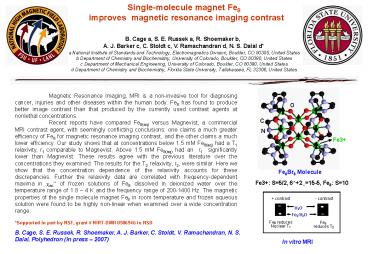Singlemolecule magnet Fe8 improves magnetic resonance imaging contrast - PowerPoint PPT Presentation
1 / 1
Title:
Singlemolecule magnet Fe8 improves magnetic resonance imaging contrast
Description:
Single-molecule magnet Fe8. improves magnetic resonance imaging contrast ... of Standards and Technology, Electromagnetics Division, Boulder, CO 80305, United States ... – PowerPoint PPT presentation
Number of Views:81
Avg rating:3.0/5.0
Title: Singlemolecule magnet Fe8 improves magnetic resonance imaging contrast
1
Single-molecule magnet Fe8 improves magnetic
resonance imaging contrast
B. Cage a, S. E. Russek a, R. Shoemaker b, A. J.
Barker c, C. Stoldt c, V. Ramachandran d, N. S.
Dalal d
a National Institute of Standards and Technology,
Electromagnetics Division, Boulder, CO 80305,
United States b Department of Chemistry and
Biochemistry, University of Colorado, Boulder, CO
80390, United States c Department of Mechanical
Engineering, University of Colorado, Boulder, CO
80390, United States d Department of Chemistry
and Biochemistry, Florida State University,
Tallahassee, FL 32306, United States
Magnetic Resonance Imaging, MRI is a
non-invasive tool for diagnosing cancer, injuries
and other diseases within the human body. Fe8 has
found to produce better image contrast than that
produced by the currently used contrast agents at
nonlethal concentrations. Recent reports
have compared Fe8(aq) versus Magnevist, a
commercial MRI contrast agent, with seemingly
conflicting conclusions one claims a much
greater efficiency of Fe8 for magnetic resonance
imaging contrast, and the other claims a much
lower efficiency. Our study shows that at
concentrations below 1.5 mM Fe8(aq) had a T1
relaxivity, r1 comparable to Magnevist. Above 1.5
mM Fe8(aq) had an r1 significantly lower than
Magnevist. These results agree with the previous
literature over the concentrations they examined.
The results for the T2 relaxivity, r2, were
similar. Here we show that the concentration
dependence of the relaxivity accounts for these
discrepancies. Further the relaxivity data are
correlated with frequency-dependent maxima in
?ac?? of frozen solutions of Fe8 dissolved in
deionized water over the temperature range of 1.8
4 K and the frequency range of 200-1400 Hz. The
magnetic properties of the single molecule magnet
Fe8 in room temperature and frozen aqueous
solution were found to be highly non-linear when
examined over a wide concentration range.
Supported in part by NSF, grant NIRT-DMR
0506946 to NSD
B. Cage, S. E. Russek, R. Shoemaker, A. J.
Barker, C. Stoldt, V. Ramachandran, N. S. Dalal,
Polyhedron (in press 2007)































